Three-Dimensional Numerical Investigation on the Efficiency of Subsurface Drainage for Large-Scale Landslides
Abstract
:1. Introduction
2. You-Ye-Lin landslide
2.1. Location of the Landslide
2.2. Climate, Topography and Geology of the Landslide
2.3. Landslide of You-Ye-Lin
2.3.1. Field Monitoring
2.3.2. Groundwater Levels
2.3.3. Ground Movements
2.3.4. Geophysical Survey
2.4. Shallow Horizontal Drains for Emergency Remediation
2.5. Drainage Well for Long-Term Remediation
2.5.1. Design of Drainage Well
2.5.2. Construction of the Drainage Well
3. Methodology
3.1. Numerical Model with Boundary and Initial Conditions
3.2. Drainage Simulation for Drainage Well and Horizontal Drains
3.3. Material Model Parameters
4. Results and Discussion
4.1. Groundwater Drawdown
4.2. Verification of Potential Sliding Surface in Dry Season without Subsurface Drainage
4.3. Comparisons of Potential Sliding Surface with and without Subsurface Drainage
4.4. Discharge Efficiency of Horizontal Drains
4.5. Considerations to the Location Adjustment of Drainage Wells
5. Conclusions
- (1)
- The effectiveness of the fully coupled flow-deformation numerical model for steady-state and transient groundwater flow calculations and slope stability analyses using SRM is verified thru (a) the calibration of the initial groundwater depth of B12-W monitoring point (−13.0 m from simulation and −12.97 m from observation); (b) the ground movement direction of the landslide (toward southeast from simulation and observation); (c) the depth of potential sliding surface (PSS) along B-B′ profile (−11.4 m for B12-W and −35.6 m for B09-W from simulation) and (−12.0 m for B12-W and −36.0 m for B09-W from observation).
- (2)
- In general, the design of the drain length Ld should pass through the PSS for an additional length and the transition length Lt1 should be situated at the main part of the sliding body to achieve the maximum groundwater drawdown result within the PSS. However, in this study, the Lt1 length locates far beyond the PSS which lowers the effectiveness of the groundwater drawdown on promoting the stability of the PSS.
- (3)
- Drainage Well-1 and Drainage Well-2 can be moved toward downslope by a horizontal distance of 24 and 10.5 m, respectively, to improve the drainage efficiency. After such an adjustment, the groundwater drawdown and slope stabilization becomes more effective on the PSS due to the fact the Lt1 length is configured within the main sliding body. In addition, the groundwater level at the downslope of Drainage Well-1 can be effectively dropped by Drainage Well-2 because of the reduction of the distance between the two drainage wells.
- (4)
- Conclusively, the drainage well may exhibit higher drainage efficiency and groundwater drawdown rate if the corresponding horizontal drains are mainly placed at the middle-zone of PSS and extend across a large area of soil mass within PSS to allow for groundwater flow into the drains.
- (5)
- For the horizontal drains situated above the groundwater table, the subsurface drainage becomes ineffective to the groundwater drawdown. For both drainage wells, the bottom horizontal drains have the highest discharge rate. In addition, the groundwater drawdown rate (or drainage efficiency) of a subsurface drainage system can be promoted with an increasing hydraulic conductivity of the colluvium, however, it may turn into uneconomical for the colluvium with a lower permeability (KS < 1.0 × 10−5 cm/sec).
- (6)
- Eventually, it should be pointed out that the subsurface drainage remediation with high engineering cost remains necessary because of the unfeasibility of the relocation of the existing three residential communities. In addition, although the locations of the two drainage wells are not optimum, still it is considered to be appropriate because of the limitation of the land availability.
Author Contributions
Funding
Conflicts of Interest
References
- Kenney, T.C.; Pazin, M.; Choi, W.S. Design of Drainage boreholes for Soil Slopes. J. Geotech. Eng. Div. ASCE 1977, 103, 1311–1323. [Google Scholar]
- Prellwitz, R.W. Analysis of Parallel Drains for Highway Cut Slope Stabilization. In Proceedings of the 16th Annual Engineering Geology and Soils Engineering Symposium, Boise, ID, USA, 5–7 April 1978; pp. 153–180. [Google Scholar]
- Nonveiller, E. Efficiency of horizontal drains on slope stability. In Proceedings of the 10th International Conference on Soil Mechanics and Foundation Engineering, Stockholm, Sweden, 15–19 June 1981; Volume 3, pp. 495–500. [Google Scholar]
- Lau, K.C.; Kenney, T.C. Horizontal drains to stabilize clay slopes. Can. Geotech. J. 1984, 21, 241–249. [Google Scholar] [CrossRef]
- Nakamura, H. Landslide control works by horizontal Drainage works. In Proceedings of the 5th International Symposium on Landslides, Lausanne, Switzerland, 10–15 July 1988; Volume 2, pp. 893–896. [Google Scholar]
- Cai, F.; Ugai, K.; Wakai, A.; Li, Q. Effects of horizontal drains on slope stability under rainfall by three-dimensional finite element analysis. Comput. Geotech. 1998, 23, 255–275. [Google Scholar] [CrossRef]
- Rahardjo, H.; Leong, E.C. Horizontal Drains in Unsaturated Soil Slopes. In Proceedings of the 3rd International Conference on Unsaturated Soils, Recife, Brazil, 10–13 March 2002; pp. 773–777. [Google Scholar]
- Rahardjo, H.; Hritzuk, K.J.; Leong, E.C.; Rezaur, R.B. Effectiveness of drainage boreholes for slope stability. Eng. Geol. 2003, 69, 295–308. [Google Scholar] [CrossRef]
- Rahardjo, H.; Satyanaga1, A.; Leong, E.C. Unsaturated Soil Mechanics for Slope Stabilization. Geotech. Eng. J. SEAGS AGSSEA 2012, 43, 48–58. [Google Scholar]
- Eberhardt, E.; Bonzanigo, L.; Loew, S. Long-term investigation of a deep-seated creeping landslide in crystalline rock. Part II. Mitigation measures and numerical modelling of deep drainage at Campo Vallemaggia. Can. Geotech. J. 2007, 44, 1181–1199. [Google Scholar] [CrossRef]
- Tacher, L.; Bonnard, C.; Laloui, L.; Parriaux, A. Modelling the behaviour of a large landslide with respect to hydrogeological and geomechanical parameter heterogeneity. Landslides 2005, 2, 3–14. [Google Scholar] [CrossRef] [Green Version]
- Matti, B.; Tacher, L.; Commend, S. Modelling the efficiency of a drainage gallery work for a large landsldie with respect to hydrological heterogeneity. Can. Geotech. J. 2012, 49, 968–985. [Google Scholar] [CrossRef] [Green Version]
- Lin, D.G. Design Guidelines of Subsurface Horizontal Drains Used for Slope Stabilization-Theory and Practice; Department of Soil and Water Conservation, National Chung Hsing University: Taichung, Taiwan, 2018. (In Chinese) [Google Scholar]
- Lin, D.G.; Chang, K.C.; Choo, E.; Su, M.B. Evaluating the Efficiency of Subsurface Drainage Systems during Large Landslides. J. Chin. Soil Water Conserv. 2018, 49, 199–213. (In Chinese) [Google Scholar]
- Long, M.T. Camp Five Slide−Exploration, Design and Construction of a Horizontal Drain Solution. In Proceedings of the 22nd Symposium on Engineering Geology and Soils Engineering, Boise, ID, USA, 24–26 February 1986; pp. 246–265. [Google Scholar]
- Royster, D.L. Horizontal Drains and Horizontal Drilling: An Overview. In Rock Classifications and Horizontal Drilling and Drainage: Transportation Research Record 783; Transportation Research Board, National Academy of Sciences: Washington, DC, USA, 1980; pp. 16–20. [Google Scholar]
- Smith, T.W.; Stafford, G.V. Horizontal drains on California highways. J. Soil Mech. Found. Div. ASCE 1957, 83, 1–26. [Google Scholar]
- Huculak, N.A.; Brawner, C.O. The use of horizontal drains in landslide stabilization. In Proceedings of the 42nd Annual Canadian Good Roads Conference, Toronto, ON, Canada, 12–16 September 1961; pp. 383–400. [Google Scholar]
- Hunt, R.E. Geotechnical Engineering Investigation Hand-Book, 2nd ed.; Taylor and Francis Group: Boca Raton, FL, USA, 2005; p. 1066. [Google Scholar]
- Cornforth, D.H. Landslides in Practice: Investigation, Analysis, and Remedial/Preventative Options in Soils; John Wiley & Sons, Inc.: Hoboken, NJ, USA, 2005; pp. 315–327. [Google Scholar]
- Crenshaw, B.A.; Santi, P.M. Water table profiles in the vicinity of horizontal drains. Environ. Eng. Geosci. 2004, 10, 191–201. [Google Scholar] [CrossRef] [Green Version]
- Xanthakos, P.P.; Abramson, L.W.; Bruce, D. Ground Control and Improvement; Wiley: New York, NY, USA, 1994. [Google Scholar]
- Hausmann, M.R. Slope Remediation. Proceedings: Stability and Performance of Slopes and Embankments-II. Geotechnical Special Publication No. 31; ASCE: Berkeley, CA, USA, 1992; pp. 1274–1317. [Google Scholar]
- Cook, D.; Santi, P.M.; Higgins, J.D. Horizontal landslide drain design: State-of-the-art and suggested improvements. Environ. Eng. Geosci. 2008, 14, 241–250. [Google Scholar] [CrossRef] [Green Version]
- Soil and Water Conservation Bureau, Taiwan. Handbook: A Brief Description of Remedial Plan for Li-Shan Landslide Area; Soil and Water Conservation Bureau: Taipei, Taiwan, 2003. [Google Scholar]
- Plaxis 3D. Scientific Manual; National Academies Press: Washington, DC, USA, 2016. [Google Scholar]
- Kleppe, J.H.; Denby, G.M. Design and Performance of Horizontal Drains. In First International Conference on Case Histories in Geotechnical Engineering; Missouri University of Science and Technology: Rolla, MO, USA, 1984; pp. 593–598. [Google Scholar]
- Hoek, E. Practical Rock Engineering; ResearchGate: Gatersleben, Germany, 2006; e-book; Available online: www.rocscience.com (accessed on 1 March 2020).
- Popescu, M.E. A suggested method for reporting landslide remedial measures. IAEG Bull. 2001, 60, 69–74. [Google Scholar] [CrossRef]
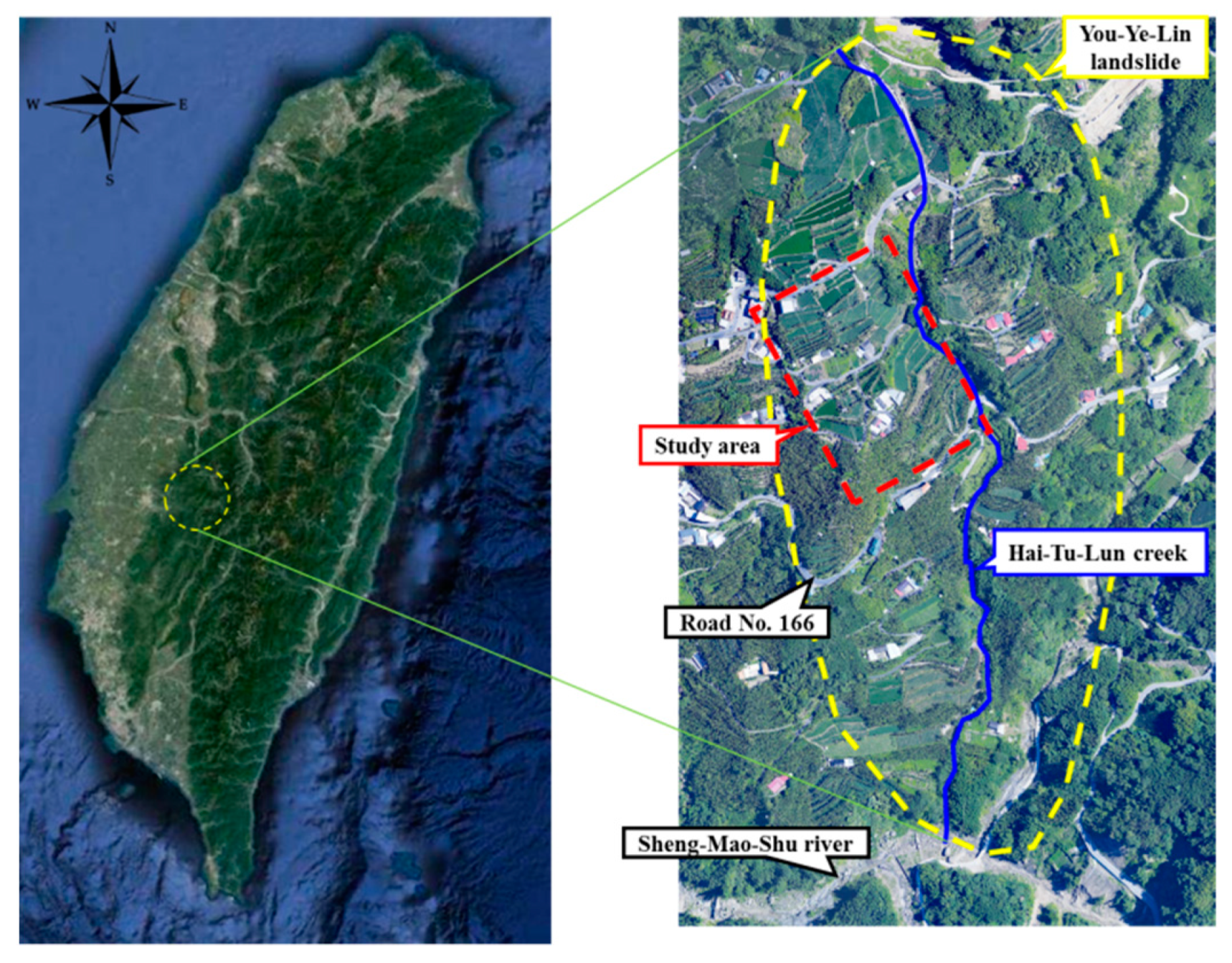



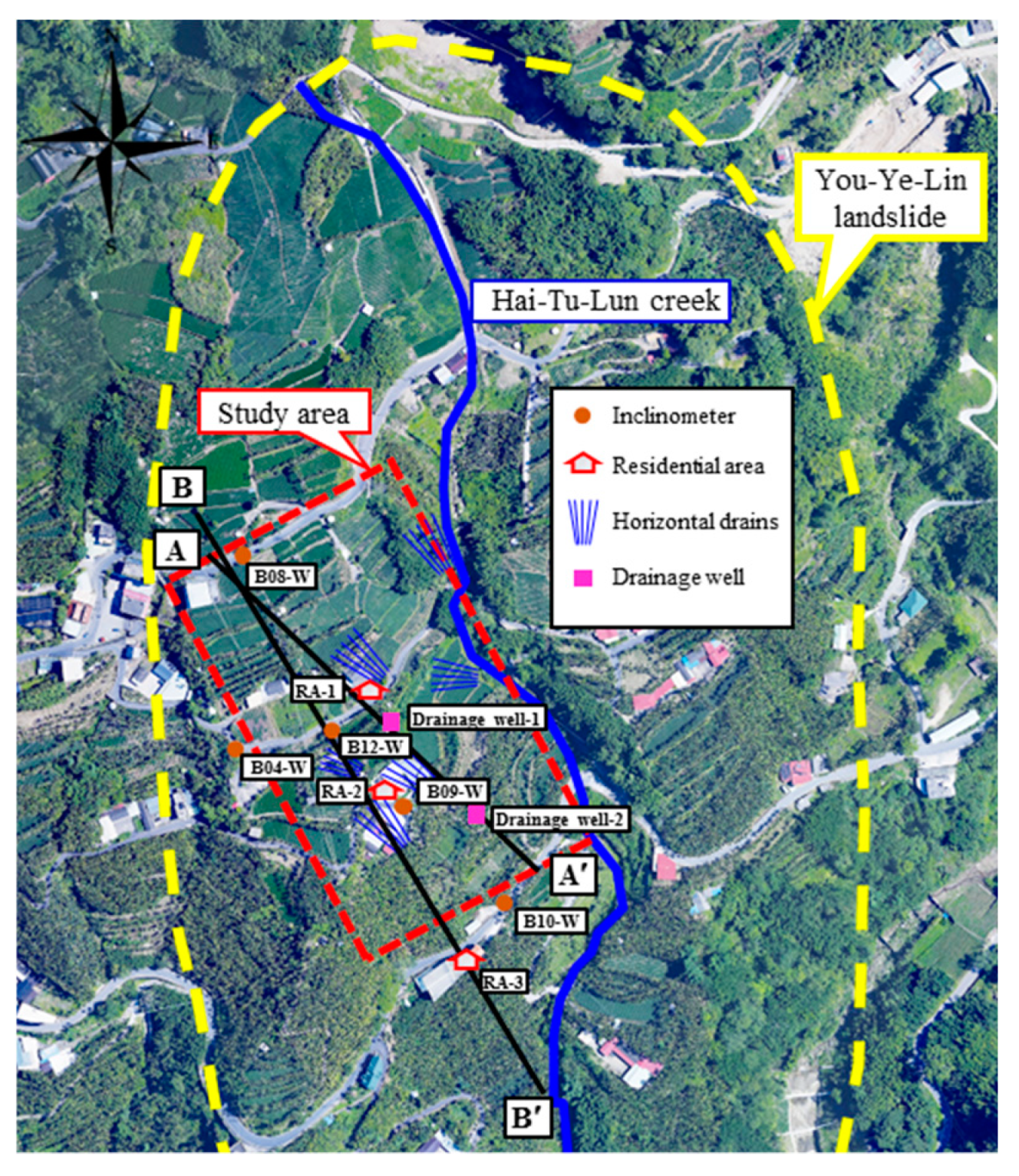

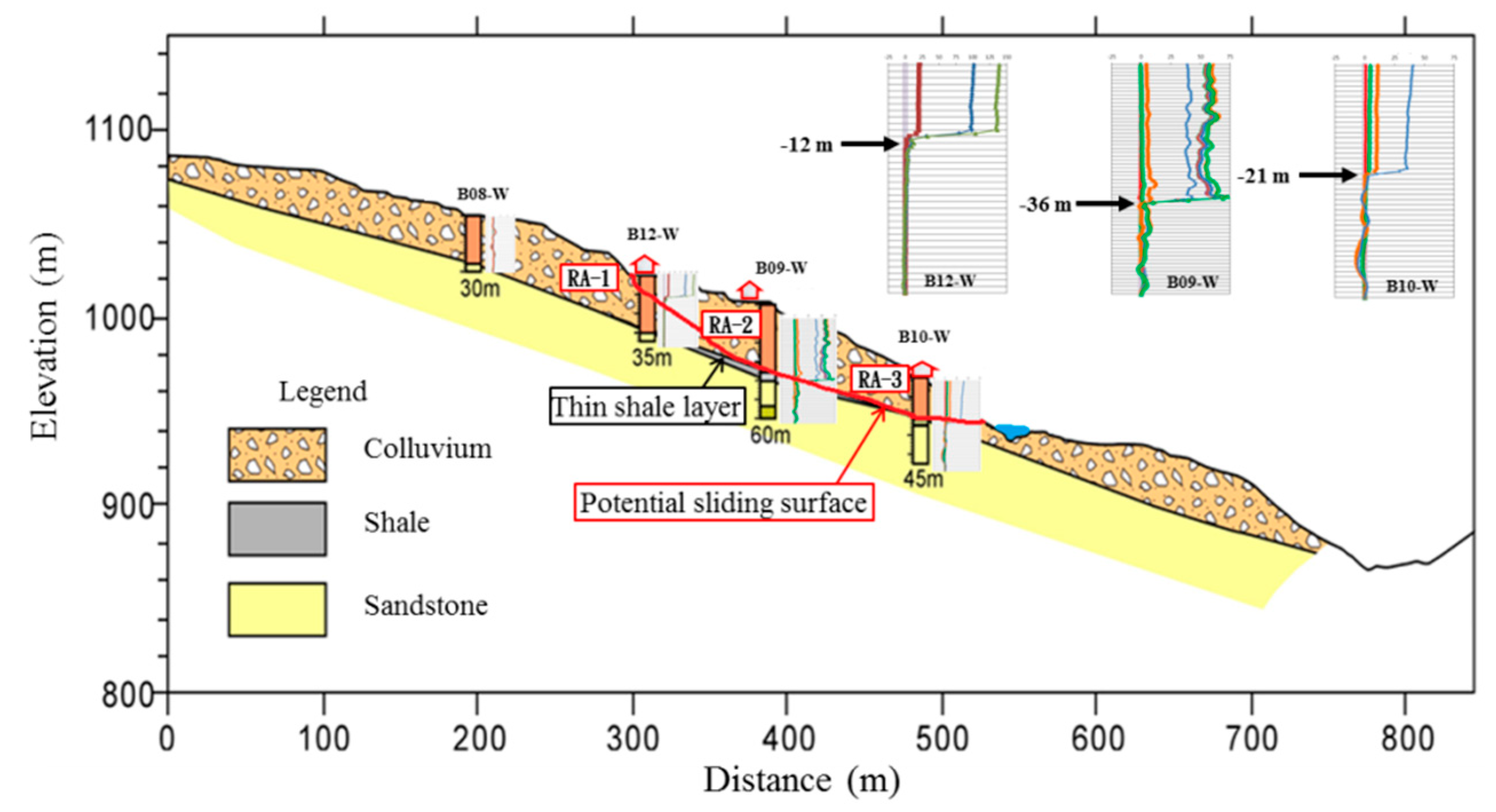
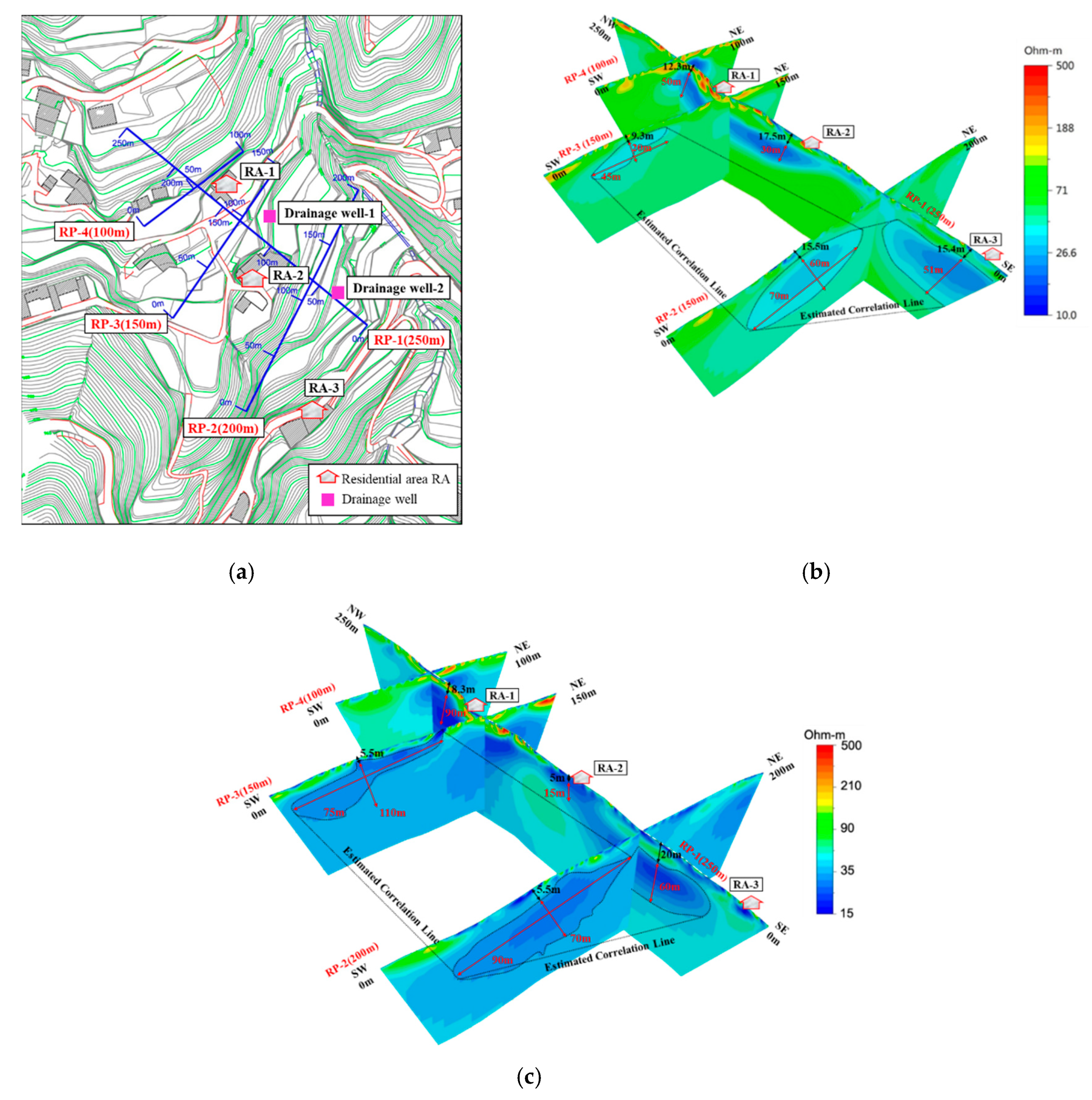
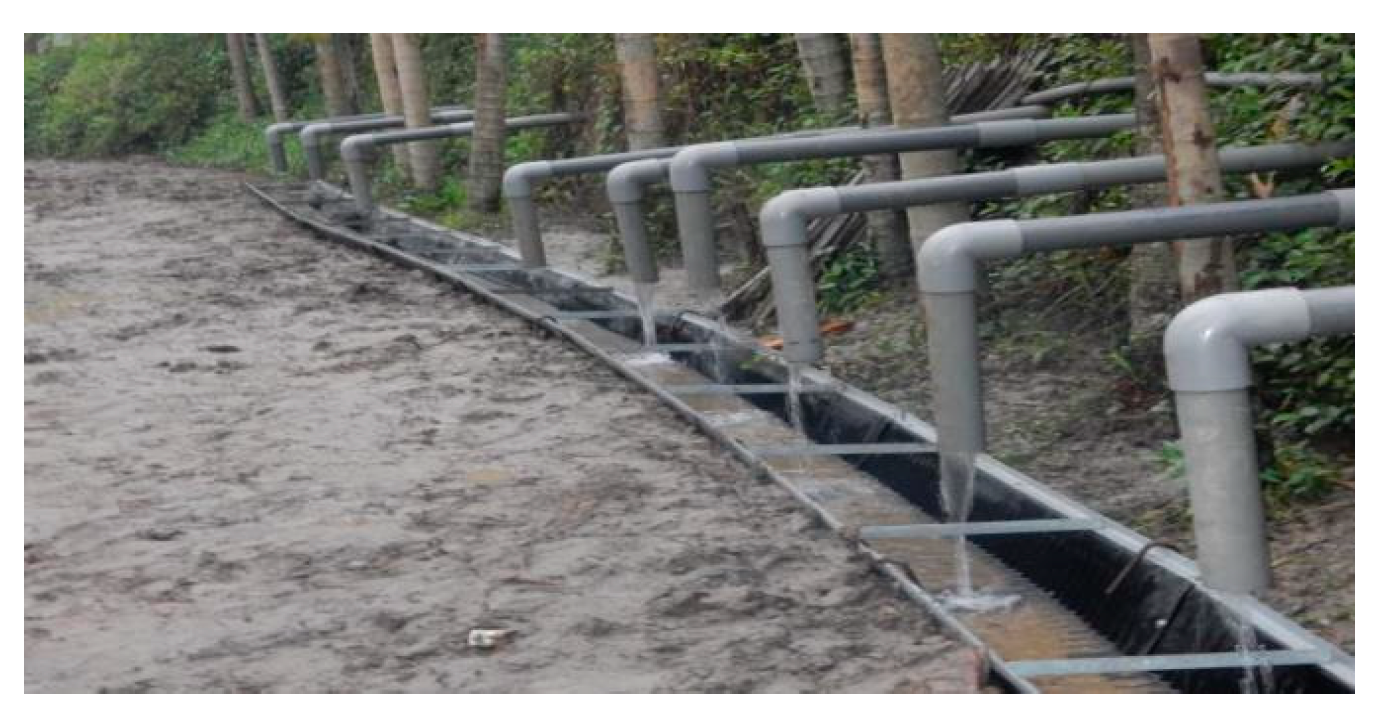
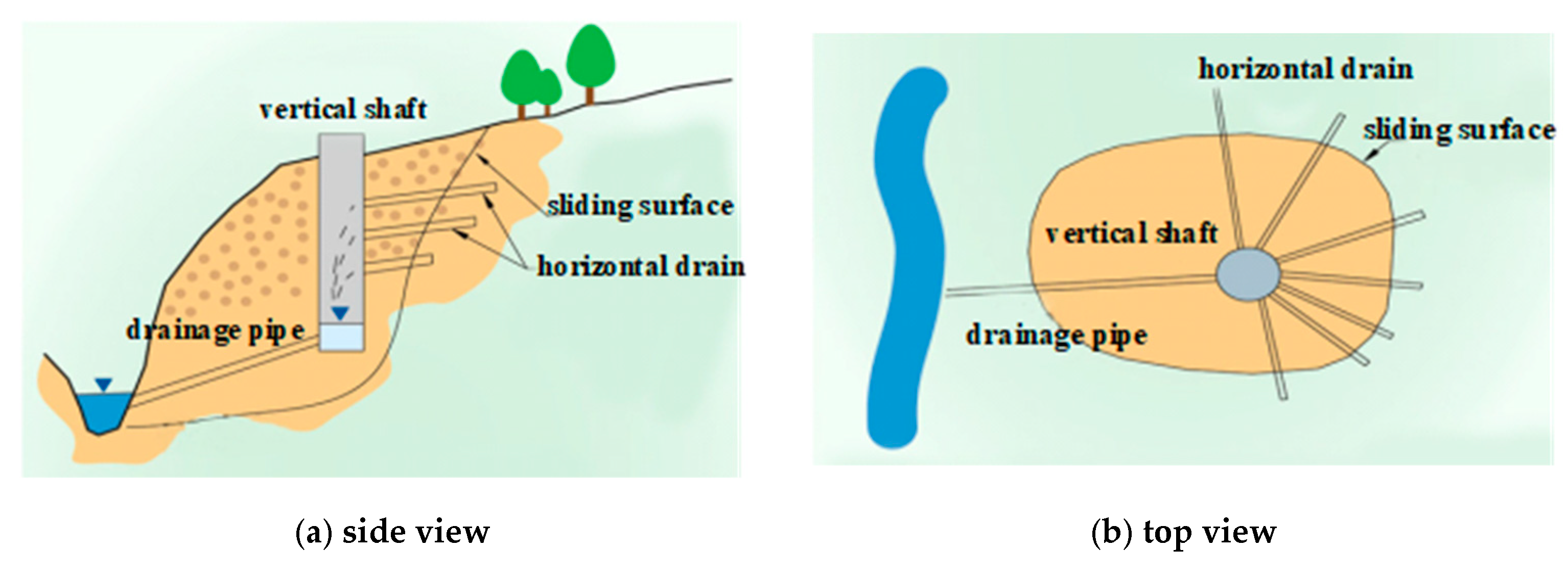



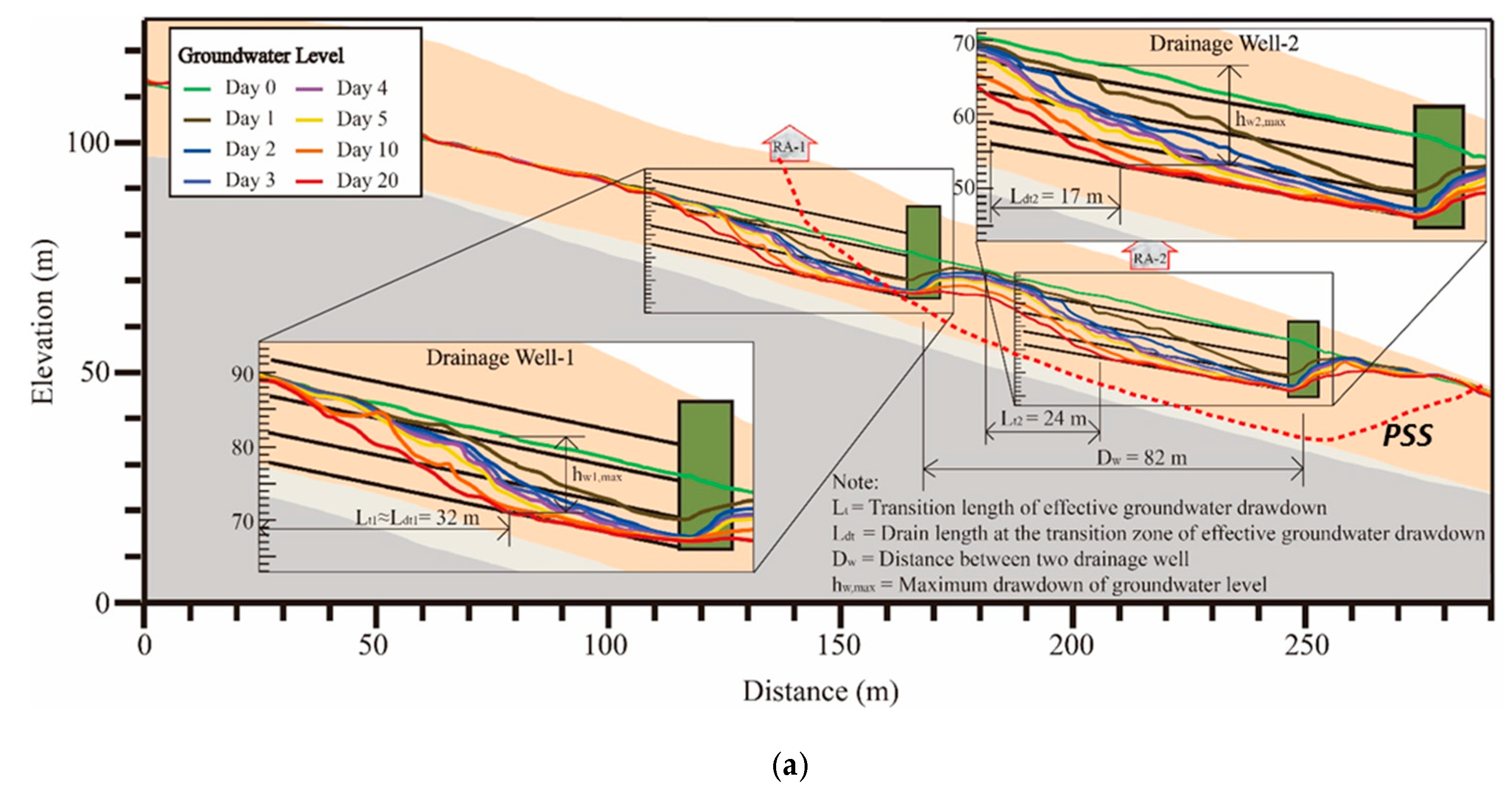
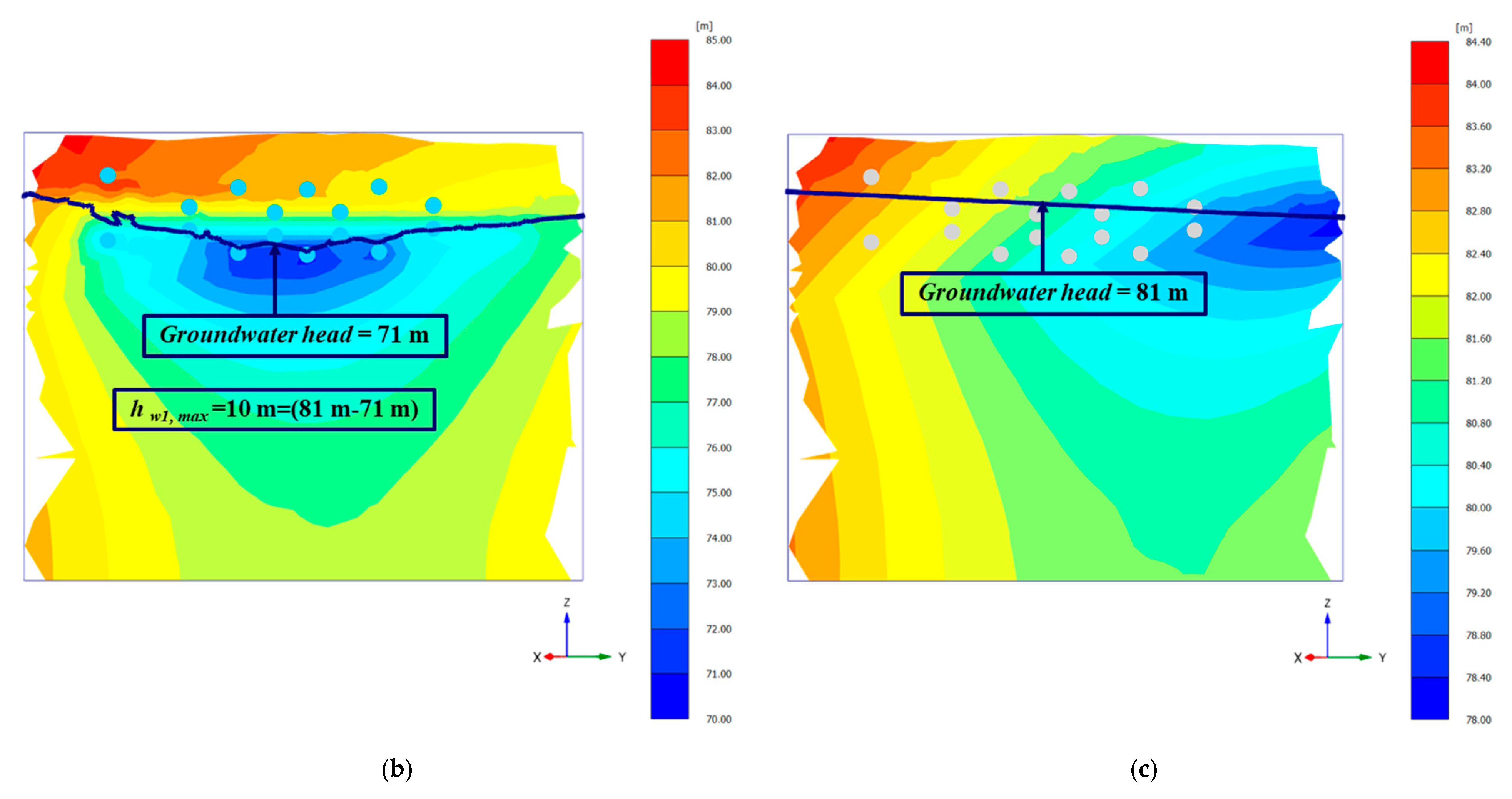
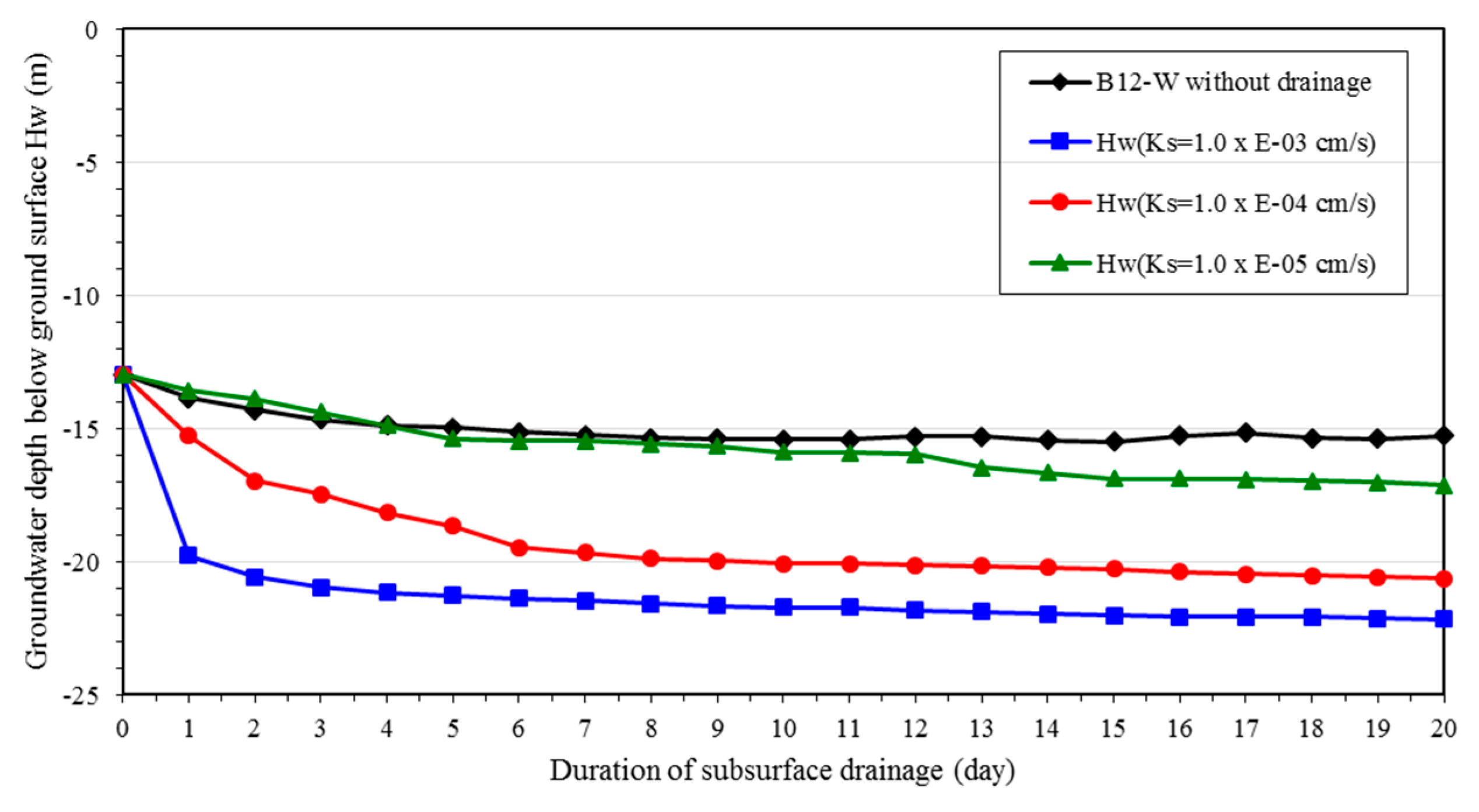
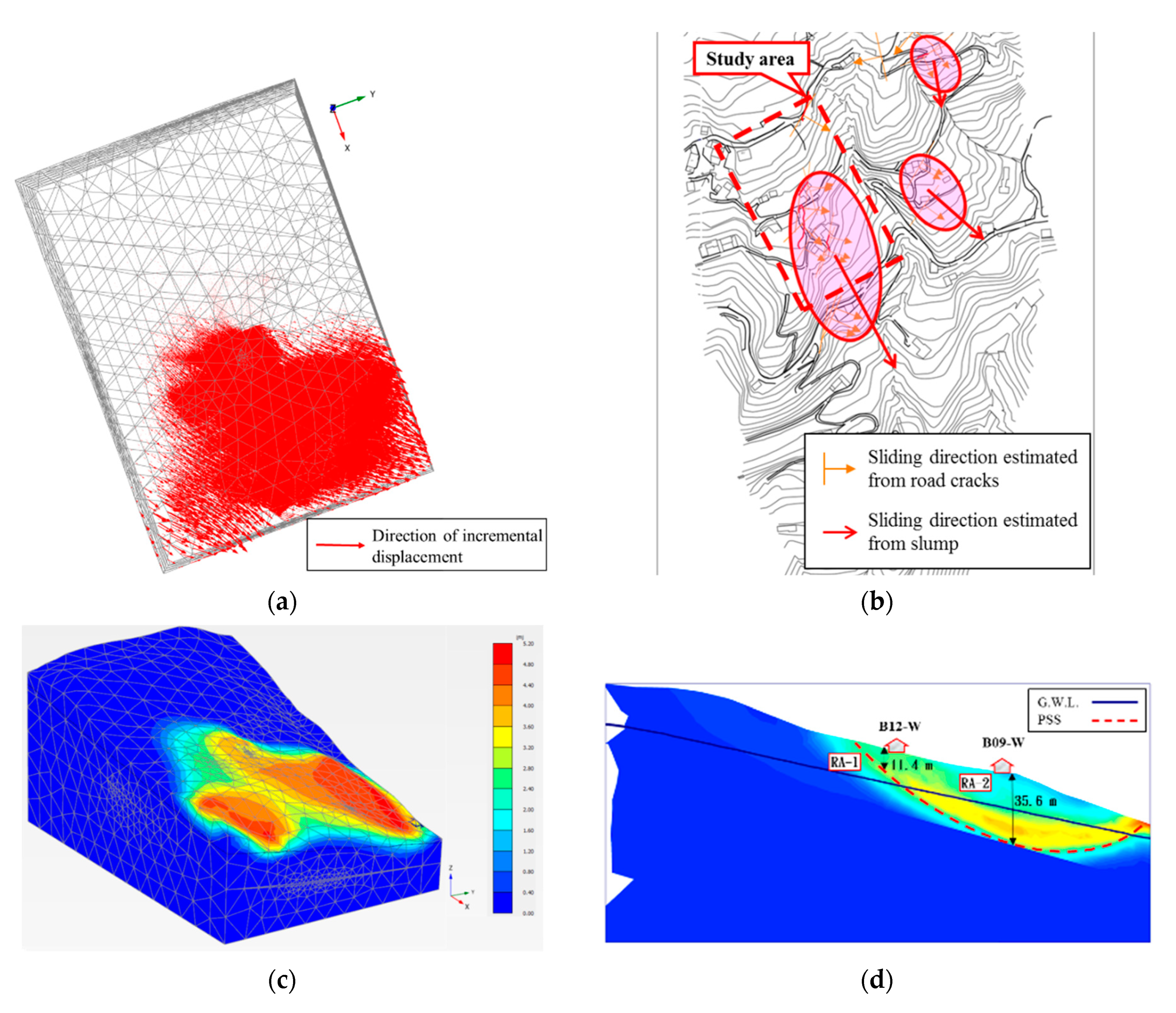
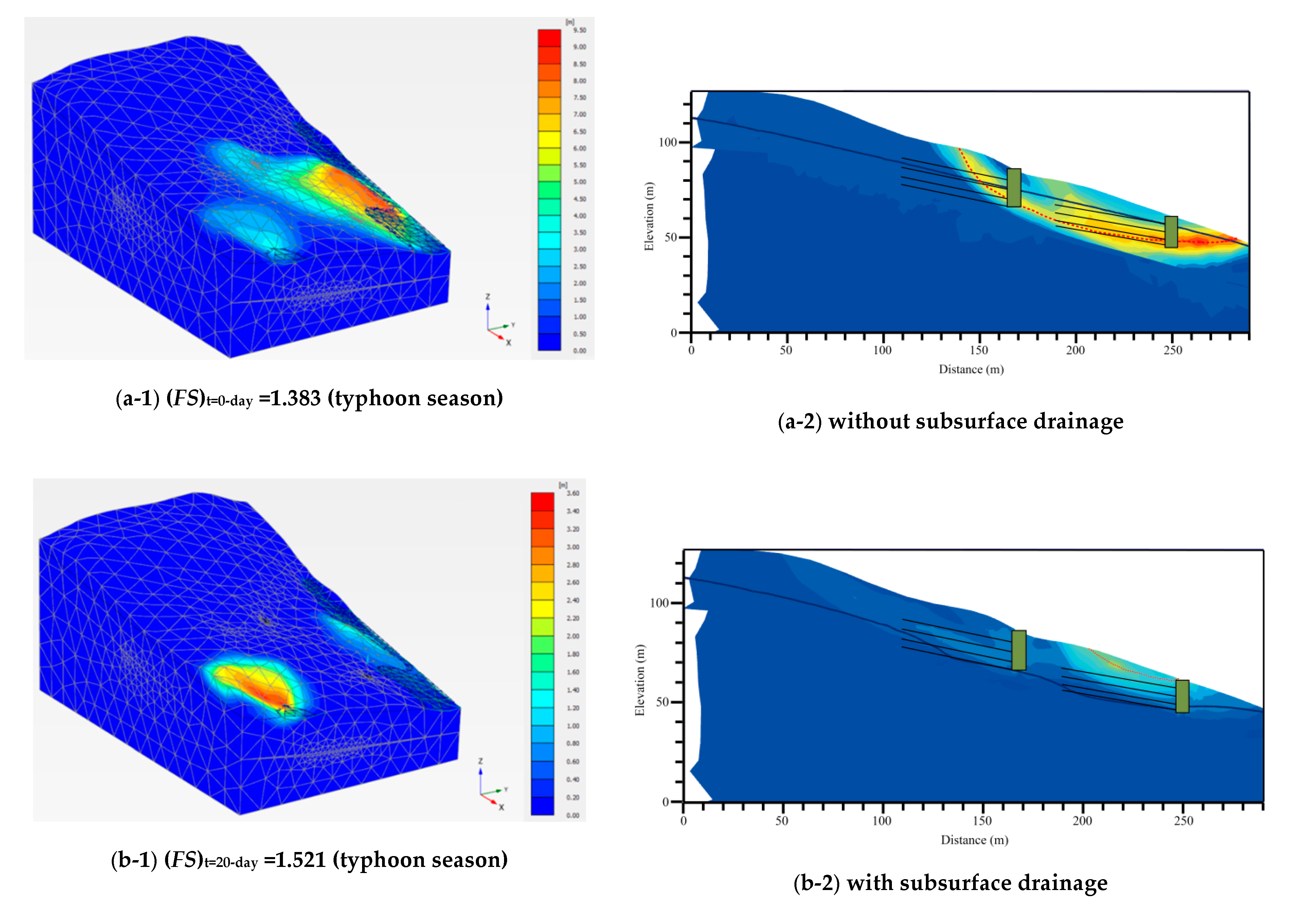

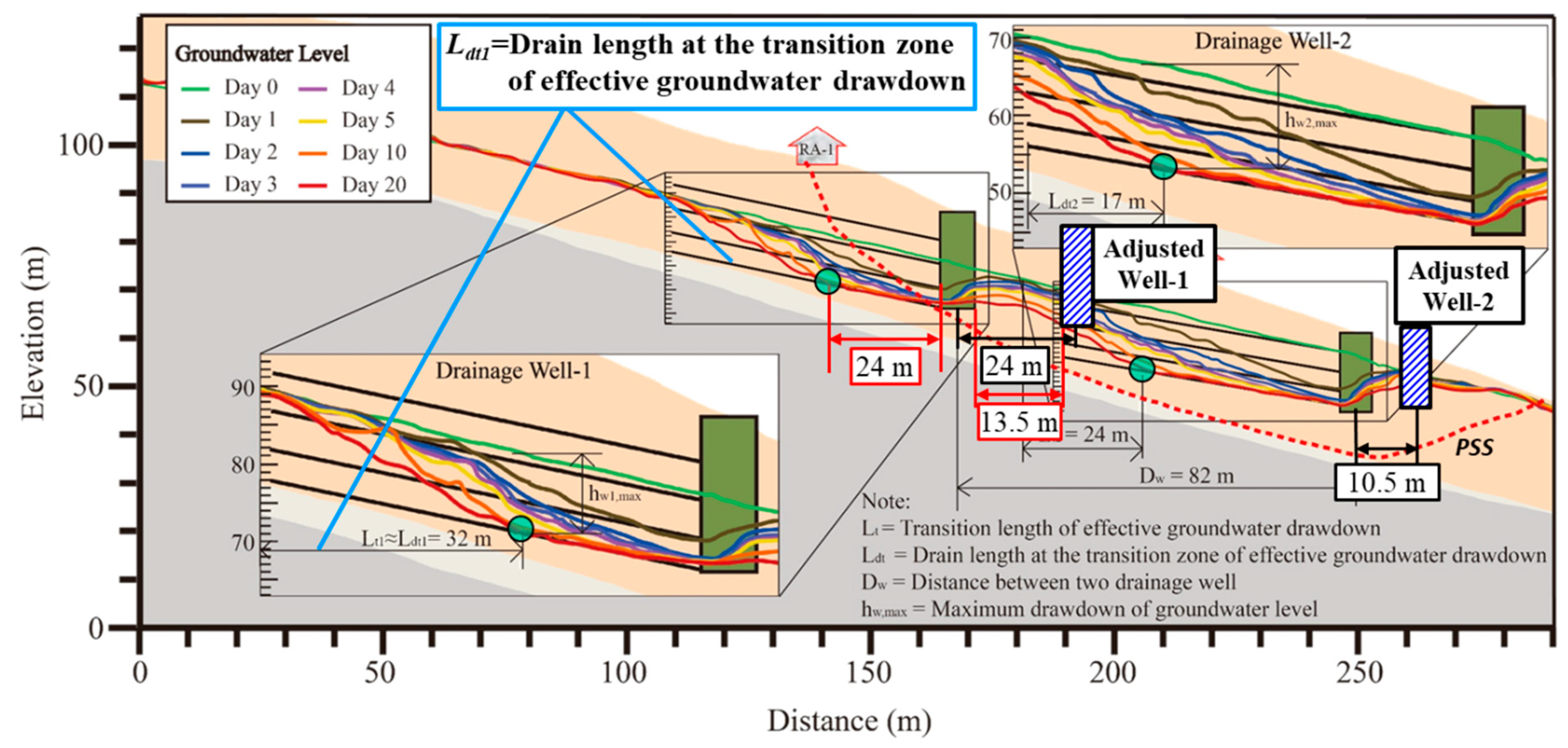
| Typhoon | Observation Well | Initial Groundwater Level (m) | Maximum Groundwater Level (m) | Groundwater Level Rise (m) | Cumulative Rainfall (mm) |
|---|---|---|---|---|---|
| Soudelor (2015/Aug./06–09) | B08-W | −11.60 | −7.39 | 4.21 | 314 252 (mm/day) 44 (mm/hr) |
| B09-W | −34.00 | −21.19 | 12.81 | ||
| Dujuan (2015/Sep./27–29) | B08-W | −6.88 | −6.72 | 0.16 | 194 144 (mm/day) 33 (mm/hr) |
| B09-W | −35.22 | −24.32 | 10.90 | ||
| Megi (2016/Sep./27–28) | B08-W | −16.20 | −15.00 | 1.20 | 484 345 (mm/day) 49 (mm/hr) |
| B09-W | malfunction | malfunction | malfunction | ||
| B12-W | −16.90 | −12.97* | 3.93 |
| Design Parameters | Drainage Well-1 | Drainage Well-2 | ||||
| Depth of well shaft (m) | 20 | 16 | ||||
| Diameter of shaft (m) | 4 | 4 | ||||
| Length of horizontal drains (m) | 50 | 50 | ||||
| Elevation and number of horizontal drains installed at 1st~4th levels (Elevation below ground surface) | Level No. | Elevation (m) | Number of horizontal drains | Level No. | Elevation (m) | Number of horizontal drains |
| 1st level | 5 | 6 | 1st level | 4 | 6 | |
| 2nd level | 10 | 5 | 2nd level | 8 | 5 | |
| 3rd level | 15 | 5 | 3rd level | 12 | 5 | |
| 4th level | 19 | 6 | 4th level | 15 | 6 | |
| Elevation angle of horizontal drains (°) | 8°~10° | 8°~10° | ||||
| Central angle of horizontal drains with fan-shape radial array (°) | 120°, 150° | 120°, 150° | ||||
| Diameter of horizontal drains (mm) | 7.62 | 7.62 | ||||
| Diameter of drainage pipe (m) | 10 | 10 | ||||
| Depression angle of drainage pipe (°) | 8°~10° | 8°~10° | ||||
| Soil Type | γunsat (γsat) (kN/m³) | Young′s Modulus E′ (kN/m2) | Poisson′s Ratio ν′ | Cohesion c′ (kPa) | Friction Angle ϕ′ (°) | Dilatancy Angle ψ (°) |
|---|---|---|---|---|---|---|
| Colluvium | 20.89 (23.37) | 2.0 × 105 | 0.30 | 10.0 | 28 | 0 |
| Shale | 21.88 (23.82) | 7.0 × 105 | 0.35 | 39.0 | 29 | 0 |
| Sandstone | 23.44 (23.84) | 7.0 × 106 | 0.30 | 0.0 | 35 | 0 |
| Material Type | Thickness t (m) | Unit weight γs (kN/m3) | Poisson′s Ratio νs | Young′s Modulus Es (GPa) |
|---|---|---|---|---|
| Steel liner | 3.2 × 10−3 | 77.0 | 0.30 | 200.0 |
| Time (day) | 1 | 2 | 3 | 4 | 5 | 10 | 20 |
|---|---|---|---|---|---|---|---|
| hw1,max (m) | 5.96 | 7.76 | 8.59 | 8.84 | 8.97 | 9.85 | 10.19 |
| hw2,max (m) | 7.96 | 9.40 | 10.24 | 10.66 | 10.93 | 11.88 | 13.00 |
| Drainage Duration t (day) | Groundwater Depth of B12-W Hw(t) (m) | Groundwater Drawdown Percentage Pdrawdown (%) | Variation of Factor of Safety FS(t) | Increasing Percentage of Factor of Safety PFS (%) |
|---|---|---|---|---|
| 0 → 1 | −12.97 → −15.27 | 17.73 | 1.383 → 1.443 | 4.34 |
| 1 → 2 | −15.27 → −16.97 | 30.84 | 1.443 → 1.479 | 6.94 |
| 2 → 3 | −16.97 → −17.47 | 34.70 | 1.479 → 1.489 | 7.66 |
| 3 → 4 | −17.47 → −18.17 | 40.09 | 1.489 → 1.499 | 8.39 |
| 4 → 5 | −18.17 → −18.67 | 43.95 | 1.499 → 1.501 | 8.53 |
| 9→ 10 | −19.97 → −20.07 | 54.74 | 1.501 → 1.510 | 9.18 |
| 19 → 20 | −20.57 → −20.62 | 58.98 | 1.520 → 1.521 | 9.98 |
| Drainage Well-1 | |||||
| Drainage Duration t (day) | Discharge Rate of Horizontal Drains at Four Elevations Qi (m3/day) (i = w1d1~w1d4) | Total Discharge Rate of Drainage Well-1 QW1 (m3/day) | |||
| w1d1 | w1d2 | w1d3 | w1d4 | =ΣQi | |
| 1 | 0.648 | 5.808 | 59.016 | 163.104 | 228.576 |
| 2 | 0.456 | 3.864 | 44.904 | 144.072 | 193.296 |
| 3 | 0.456 | 2.664 | 37.128 | 129.576 | 169.824 |
| 4 | 0.456 | 2.160 | 32.616 | 117.120 | 152.352 |
| 5 | 0.480 | 1.896 | 29.832 | 106.728 | 138.936 |
| 10 | 0.624 | 1.032 | 21.312 | 78.648 | 101.616 |
| 20 | 0.048 | 0.480 | 16.008 | 58.848 | 75.384 |
| Drainage Well-2 | |||||
| Drainage Duration t (day) | Discharge Rate of Horizontal Drains at Four Elevations Qi (m3/day) (i = w2d1 − w2d4) | Total Discharge Rate of Drainage Well-2 QW2 (m3/day) | |||
| w2d1 | w2d2 | w2d3 | w2d4 | =ΣQi | |
| 1 | 7.848 | 21.696 | 101.760 | 236.664 | 367.968 |
| 2 | 2.808 | 14.592 | 76.704 | 214.440 | 308.544 |
| 3 | 2.424 | 10.368 | 60.432 | 195.696 | 268.920 |
| 4 | 2.544 | 8.208 | 51.456 | 182.112 | 244.320 |
| 5 | 1.488 | 6.984 | 45.816 | 171.552 | 225.840 |
| 10 | 0.384 | 3.408 | 32.832 | 140.736 | 177.360 |
| 20 | 0.240 | 1.296 | 24.264 | 119.112 | 144.912 |
© 2020 by the authors. Licensee MDPI, Basel, Switzerland. This article is an open access article distributed under the terms and conditions of the Creative Commons Attribution (CC BY) license (http://creativecommons.org/licenses/by/4.0/).
Share and Cite
Lin, D.-G.; Chang, K.-C.; Ku, C.-Y.; Chou, J.-C. Three-Dimensional Numerical Investigation on the Efficiency of Subsurface Drainage for Large-Scale Landslides. Appl. Sci. 2020, 10, 3346. https://doi.org/10.3390/app10103346
Lin D-G, Chang K-C, Ku C-Y, Chou J-C. Three-Dimensional Numerical Investigation on the Efficiency of Subsurface Drainage for Large-Scale Landslides. Applied Sciences. 2020; 10(10):3346. https://doi.org/10.3390/app10103346
Chicago/Turabian StyleLin, Der-Guey, Kuo-Ching Chang, Cheng-Yu Ku, and Jui-Ching Chou. 2020. "Three-Dimensional Numerical Investigation on the Efficiency of Subsurface Drainage for Large-Scale Landslides" Applied Sciences 10, no. 10: 3346. https://doi.org/10.3390/app10103346





